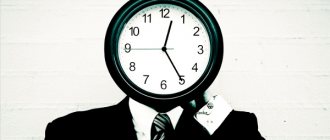Good health, comrades, all people are divided according to their biological rhythms mainly into “night owls” and “larks”. There is also a transitional division - “pigeons” are people who live according to their own daily rhythms and cannot be called “owls” or “larks”. Statistics show that most municipal citizens are night owls, while people living in rural areas are early risers. Therefore, they all start their day in their own way: they wake up and have breakfast at different times, then, as a rule, they go to work, where they also have different activity peaks. From the publication you will learn how to find out your chronotype - are you a “night owl” or a “lark”, what are the differences in biorhythms between individuals of these two types, and what the correct diet should be.
How to optimize the mode
So, you can’t argue with biochemistry, but you have the power to make your life a little less unbearable. If you want to get up earlier in order to get more done, do not try to instantly and radically change your routine: you will waste time, lying in bed from 9 pm with glassy eyes, and still waking up. You can try to make the morning start to be pleasant and become a full-fledged part of the day.
Ventilate your bedroom, don’t let yourself fall asleep in a stuffy room, clogged with yesterday’s germs and problems. If possible, sleep in the cold, but under a secure blanket.
When you close your laptop to go to bed, don't grab your phone to finish reading your news feed under the covers. The glow of the display prevents your body from recognizing sleep commands.
Don't force yourself with sudden loud alarms. Try waking up using your phone's vibration alert or soft music. A soft alarm is also included with most tracker apps and gadgets that track sleep stages and consider it a beneficial exhaust.
Don't eat at night. At night - two hours before bedtime. A full stomach, actively digesting food, prevents natural sleep and can even cause nightmares.
No compromises and “half an hour and I’ll get up.” It’s much more effective to run to the shower or make coffee without regaining consciousness: on the way, the daily schedule, task list and other horrors of the world around you will have time to load into your memory.
Try to go to bed at the same time every day. Not necessarily at 10 pm, but definitely before midnight.
Who is right?
However, the truth is that scientists’ attempts to “reshape” the biorhythms of living beings failed - it turned out that it was impossible to do this without harm to health. According to somnologists, it is possible to optimize the work process only taking into account the individual characteristics of employees, but a forced transition to a “lark” will bring nothing but harm.
“Once I had to disrupt my entire life schedule (and I’m a typical “biological night owl”) in order to perform some early official functions,” says Anna from Moscow
. “I started to feel depressed and my performance decreased. This lasted for several months. Moreover, I didn’t solve any serious problems in the morning mode, I just sat through the allotted hours in a half-dead state, but this killed my entire schedule and paralyzed the solution of serious problems. Then, during the New Year holidays, I returned to night mode, and everything stabilized. But after the end of the holidays I was again forced to adapt to the early schedule, and complete “trash” began. In the very first weeks of such a life, in addition to a critical loss of working capacity, general weakness and depression, I developed psychosomatics and my immunity dropped. Despite the fact that in peacetime - neither in summer nor in winter - I practically do not get sick, I was immediately blown away on the street, some other problems began, everything came out that had never happened. As a result, I spent almost a month on antibiotics. Now the schedule has returned to the nightly norm, and (knock on wood) I have no complaints about my well-being and performance.”
Russian researchers of the problem, for their part, note: from early childhood, people are terrorized by early rises and initiation into adult life with “cold and darkness”, so that the morning is associated exclusively with violence against oneself and the need to drag oneself to hard labor, but there is no particular need for this. The labor productivity of owls is higher, and they “screw up” only if they are forcibly transferred to the morning mode.
What are they, “feathered”
Larks:
- They wake up early without any additional effort and feel cheerful, energetic, and rested.
- Functionality is maximum in the morning until noon.
- By the end of the day, exhaustion increases, the supply of vital energy disappears and, if circumstances permit, they go to bed early.
- Health parameters are better than those of owls.
- It is difficult to adapt to a new work routine and lifestyle.
Representatives of this type go to bed in the evening an hour and a half earlier than owls, and get up in the morning two hours earlier than the obvious owl.
American experts, Webb Wheels and Bonnet Michael, came to interesting conclusions:
- Larks are happier with their sleep than owls. They sleep an equal number of hours every day, which ensures excellent sleep quality.
Character Traits:
- Larks are pliable, love serenity, they are insecure, mentally changeable and withdrawn, conservative, punctual, and straightforward. They can be despots.
- In the business world, they are respected for their self-discipline, precision and high functionality.
Owls:
- Getting up in the morning is extremely difficult and unsettles you until noon.
- Efficiency in the morning is minimal, by sixteen o'clock it increases, and its peak occurs in the twilight hours and at night.
- They go to bed much later than midnight.
- Their biorhythms are more flexible, they tolerate changes in their usual routine more easily.
Character traits:
- The Owl is an emotionally stable person who takes failures lightly and is not afraid of problems and stress. The character is serene and cold-blooded. She is predisposed to logical thinking, maintains composure in difficult moments, and does not give in to confusion.
- “Critical” professions are suitable for “night owl” people - astronauts, firefighters, pilots, sappers.
Pigeons, their experts call arrhythmics, belong to the hybrid type; they can be both larks and owls.
- Adapts perfectly to free mode.
- Functionality is maximum around three o'clock in the afternoon.
- They go to rest at approximately 23:00.
According to statistics, 40% of the total population of the Earth is formed by owls, larks - 25%, and the rest - pigeons.
What Science Says
Owl, lark and ... Archeopteryx
All we can say is that no one has proven that such division is due to differences in genetics or physiological characteristics, and not personal preference . Recently, a theory has emerged from Roger Ekirch, who connects such differences with the advent of electricity.
By the way, even if we take the very concept of chronotypes, which are “owls”, “pigeons” and “larks”, it arose relatively recently - it finally took shape by the 70s of the last century.
The bottom line : before the invention of electricity, until the 19th century, all people were larks for the most banal reason - the only available and free source of light was the sun and they had to take this into account and spend up to 14 hours a day in the dark.
Even after time, only wealthy people could afford abundant candlelight, which was enough for leisure activities. But of course, a solution was found: biphasic sleep.
People went to bed almost immediately after sunset, slept for about 4 hours, and then woke up and stayed awake for a couple of hours, doing different things: those who were richer, read or prayed. In the 15th century there were even special prayers for night vigils. But most often they created because they felt something akin to inspiration.
The poor, according to the scientist, “indulged in carnal pleasures.” This explains Ekirch's high birth rate in these social groups. After midnight activity, people went back to bed and slept until the first rooster.
Circadian rhythms
An important point in the discussion of chronotypes. We all have the so-called. circadian rhythms, which are also called circadian rhythms. They control the sleep-wake cycle, the feeling of hunger, the desire to have sex, the functioning of the cardiovascular and digestive systems and other processes occurring in the body.
Their discovery is of great significance: in 2021, the scientists who studied them were awarded the Nobel Prize for the discovery of the molecular mechanisms that control the circadian rhythm.
Many people, when talking about circadian rhythms, fall into outright shamanism and esotericism, beginning to explain everything in the world with special energy flows. But the position of science on this issue is more clear: yes, they exist, yes, they influence, but they are changeable.
Circadian or circadian rhythms (from the Latin circa “around, around” and dies “day”) are cyclic fluctuations in the intensity of various biological processes associated with the change of day and night. The period of circadian rhythms is usually close to 24 hours.
Despite the connection with external stimuli, circadian rhythms are determined by internal factors. This is a kind of biological clock of the body that helps it in its work. The most important factor regulating the action of these cycles is light .
Light in the morning helps you wake up and subsequently fall asleep earlier, light in the evening leads to delays in rhythms and a later bedtime. This is ensured with the help of special cells from the retina, which transmit information immediately to the suprachiasmatic nucleus, which controls biorhythms.
This is one of the most important things you need to know if you want to improve your sleep. For example, about 50% of completely blind people have non-24-hour sleep-wake syndrome. Their circadian rhythm cannot adjust to the 24-hour clock and they fall asleep later and later every day.
The suprachiasmatic nucleus controls the production of hormones that regulate the body's circadian activity. The signal entering the pineal gland causes the synthesis and release into the bloodstream of the sleep-inducing neurohormone melatonin , also a key participant in the process.
When there was too much light before bed
But there is one thing (forgive the tautology): circadian rhythms can adapt to your lifestyle. Moreover, a person is not born with a ready-made sense of time; circadian biorhythms are not available in a ready-made and complete form at the time of birth, but are formed in the process of development based on the individual time scale of the growing organism.
The effect of biorhythms on health
You should know your biorhythms, predetermined at the genetic level, listen to them and try to follow them in order to avoid health problems.
It is most vulnerable in women, which is explained by the cyclical nature of most processes in their body.
Owls and larks react differently to jet lag.
Larks,
- Having the highest health indicators, it is the most difficult for them to adjust to a different rhythm of life, which negatively affects their mood, well-being and health.
- If their natural regime is disrupted, their immunity sharply decreases, which provokes frequent colds. This type is characterized by heart disease.
Owls
- are surprisingly resistant to stress; with age, their health potential catches up, and by the age of 50, surpasses that of early risers. They are more cheerful and less susceptible to depression.
- However, they are more susceptible to hormonal imbalances: the average daily release of hormones that ensure their activity at night is 1.5 times higher than that of larks. As a result, they are more likely to develop diabetes. Also, peptic ulcers are more common in this category.
Pigeons are considered the most adaptable and resistant to regime failures. They can easily adjust to one rhythm or another without harming their health.
Centuries of discrimination
One way or another, the world is “tailored” for “larks”, and “night owls” are historically discriminated against and are included in the category of lazy people who do not want to adapt to the collective farm and get up with the roosters to make hay - with all the sanctions, reproaches and accusations that result from this. “Are you like the chosen one?” - they say to the night owls, trying to instill in them a false sense of guilt for absolutely normal biological characteristics and adapt them to production needs.
The tradition of collective censure and condemnation of “owls” goes back to ancient times, when late travelers could be attacked by night predators, as a result of which the tribe was left without extra labor, or even had to spend money on burying the remains. In addition, sources of fire and light were worth their weight in gold, and the “owls,” who egocentrically transferred valuable goods at night, went against the collective interests. Guided by the same considerations, women in Rus' in the old days tried to clean up before dark, simultaneously generating numerous signs about the imminent financial collapse of household ownership if they washed the floors after sunset and other heresy in the same spirit.
Of course, with such dominant social consciousness, many “night owls” are forced to cave in, but this ends sadly: you can ruin not only labor productivity, but also health. As scientists from Harvard found out several years ago, a third of the US working population regularly lacks sleep and works at half capacity, and employers suffer huge losses due to lack of sleep among employees and futile attempts to correct this situation. Falling productivity costs American companies $63.2 billion annually, but instead of accepting reality, they are trying to force night owls to sleep at night.
Dependence on age and gender
Children are usually “early people,” but with age, more and more of them become “night owls”—the maximum is reached at approximately 20 years of age, and in women about 1.5 years earlier than in men. Then, with age, the chronotype gradually becomes early. Men, on average, have later chronotypes for most of their adult lives.
In these studies, the chronotype of each of the respondents (approximately 25,000 people, mainly from Germany and Switzerland) was determined by the midpoint of sleep on free days (MSF). The technique (the so-called Munich test was used - English Munich Chronotype Questionnaire, MCTQ) is based on the fact that most chronotypes tend to accumulate sleep debt on weekdays, which is compensated on weekends by longer sleep with a corresponding shift in the middle of sleep to later hours .
Both types of people are more creative at inconvenient hours
When a person's lifestyle matches their chronotype, it is clearly beneficial. But the occasional mismatch is not the end of the world. And it can even generate additional creativity, as psychologists Mareike Wit and Roz Zaks show in a 2011 study. They determined the chronotype of 428 test participants and then randomly assigned them to morning and evening sessions. During the test, they had to solve six problems - some analytical, based on logic, and others based on intuition and a surge of creative thought.
Wit and Sachs write in the journal Thinking and Reasoning that, in general, people were more successful at solving analytical problems. But they were better able to solve problems that focused on intuition when they were presented with them at a non-optimal time—for example, if the night owl received such a problem in the morning. These results support one theory of creativity: when you take your mind off a problem, often due to mental fatigue, it can produce unexpected solutions.
Original article.
“Ideonomics” are interesting and practical ideas about business, life and self-development, collected from foreign media and blogs in one place in Russian.
Advantages and disadvantages
The rhythm of life in modern industrial society is more suitable for “larks” or “pigeons” - early awakening, work during daylight hours. In this sense, they are in a more advantageous position. In addition, early risers tend to have slightly better overall health indicators. At the same time, “larks” tolerate temporary changes in the rhythm of life worse than others and take longer to adapt to long-term changes. One or two sleepless nights can unsettle you for several days, and moving to a different time zone can require lengthy adaptation.
“Owls” experience difficulties with constant daytime work: they have to resort to tonics in the morning, and still they cannot really work actively in the first half of the day. At the same time, they tolerate short-term changes in the rhythm of life much more easily and adapt better to shift work. In addition, it has been noted that in adulthood, “night owls” maintain better health and are generally psychologically more stable than “larks”; The exact reason is unknown; according to some assumptions, this is a consequence of many years of adaptation to life in the “morning” rhythm.
“Pigeons” are well adapted for living and working in a “daytime” rhythm; moreover, they quite easily tolerate a shift in the daily rhythm of two to three hours “forward” or “backward”. However, they are more prone to psychological problems and depression than “larks” and “night owls”.
Features of biori
People belonging to the intermediate chronotype “Pigeons” are characterized by the following behavioral features.
Awakening
People with a similar rhythm of daily activity wake up without problems when the alarm goes off. Given a normal life schedule, they tend to get up at 7–9 am.
Diet
It is preferable for “pigeons” to eat an hour after waking up - at this time the stomach begins to fully function, “getting rid” of the state of drowsiness. For breakfast, it is recommended to eat a light meal consisting of plant proteins and fiber. The best options for the morning menu are porridge and fermented milk products.
Job
Physical activity is evenly distributed throughout the day, so the “pigeons” do not complain about their performance, managing to complete the planned tasks during the shift. However, in the period from the moment of awakening to 1800, people belonging to this category of chronotypes experience a sharp decline lasting 1 hour. During this period of time, the “pigeons” gain strength and energy, which is enough for them to rest.
Sport
In the daily routine of people with a similar chronotype, there are no peaks of physical activity, so for training you can choose the time from the following range - from 7–9 to 22–23 hours. You shouldn’t overdo it too much in the gym so as not to disrupt your established life schedule. Dramatic changes in the daily routine of “pigeons” cause depression, becoming prerequisites for being in a long-term state of stress.
Dream
Being in the usual rhythm of life, representatives of the chronotype of the postal bird prefer to go to bed at 23–24 hours. At this moment, people experience a noticeable decline in physical activity, so forcibly continuing to work is an inappropriate solution.
Of the generally accepted varieties of human chronotypes, “pigeons” most painlessly tolerate rare shifts in the schedule for 2–3 hours, adapting to the new regime in an emergency situation. If you belong to this category, then do not worry about your condition the day after a “stormy” night. You will invariably quickly get used to it, getting rid of suspended animation and getting into a working rhythm.
If a person “listens” to the needs of his own body in time, changing his daily routine in accordance with his genetic predisposition, then he can forget about sleep problems. The results of the correct regime are improved well-being, increased immunity, emotional stability and high spirits.
If you are an owl
Characteristics of biorhythm. You have difficulty waking up, prefer to lie in bed longer, and in the morning everything falls out of your hands. However, once you get the hang of it, you can work productively into the night without getting tired.
Diet characteristics. It is important to correctly plan your diet, with the condition that the digestive system of “night owls” awakens no earlier than a couple of hours after getting out of bed. Immediately after waking up, the “owl” needs not so much to eat as to drink, this will also rid the body of night toxins. Therefore, such people should start their morning with one or two glasses of purified water at room temperature (filtered or boiled). Having waited until the water starts the metabolic processes in our body, we can start eating, but it must be light and non-caloric, since you will have to spend the acquired energy not in the first, but in the second part of the day.
Suitable menu for owls
Whether you're a night owl or a morning person, start your day off right so that your day gets off to a strong start and gives you the strength to get everything done. Don't eat on the go. Allow at least a quarter of an hour for breakfast. It has long been noted that if a person enjoys his morning meal, then his working day will go well.
Breakfast – 3 variations for every day
For breakfast you can include dishes made from eggs, dairy products, fruits and vegetable salads.
Variation 1
- Simple vegetable salad.
- Any fruit or freshly squeezed juice.
Variation 2
- Scrambled eggs from one egg.
- Vegetable salad.
Variation 3
Yogurt or fresh cottage cheese with fruit (you can make a smoothie).
Lunch for owls
For lunch, it is preferable to choose warm dishes - meat and fish, including casseroles with vegetables, soup with meat, poultry or fish.
Dinner for owls
Late birds should have two dinners:
- The first is more abundant between 18.00 and 19.00.
- The second, simpler one is best done no later than 1.5–2 hours before bedtime.
The main dinner can be hearty - a dish of fish, poultry or meat with a side dish and a vegetable salad.
For your next dinner, give preference to a glass of fermented milk drink or 200 g of cottage cheese.
It is advisable to stop eating right before bed. And in order not to suffer from insomnia, you should prepare for bed in advance. About 30 minutes before, you need to turn off the computer or TV, maybe take a soothing bath, or just walk. A glass of warm milk with honey promotes deeper sleep. And don't forget to ventilate the room!
If you are a morning person
Specificity of biorhythm. You wake up at the first cockerel, work fruitfully in the first half of the day, and after lunch you feel a loss of strength. By evening, fatigue accumulates, and you feel an urgent need to go to bed early.
Nutrition specifics. “Lark people” need a hearty breakfast - it will give them the necessary supply of calories that will supply the body with energy for the foreseeable two to three hours. This will be followed by an energy decline, which must be replaced by light carbohydrates by midday. In this case, it’s great to have a delicious piece of fruit, a bag of juice or some dried fruit with you.










